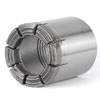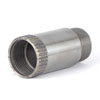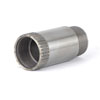- Operating parameters
- Bit Load
- Bit Hydraulic
Operating parameters
The information contained in this section is intended as a technical guide for the field application of IDP core drilling bits. To use these products successfully, it is necessary for the driller to provide some control over the three primary operating parameters, which are:
Bit Load or weight on bit (WOB) - the thrust applied to the bit during drilling, Rotational Speed and
Bit Hydraulics - the type of circulating fluid and the rate at which it is pumped through the bit during drilling.
The technical application data provided here is intended as a basic guideline for the selection of the appropriate tools for your job and the normal operating requirements for their application. As drilling conditions and the capabilities of drilling equipment vary considerably from site to site, it is impossible to define absolute application recommendations. Some experimentation on the part of the user may be required as operating parameter values outside of the ranges suggested here, might be applicable to your particular conditions. Technical support is available by contacting IDP directly.
Conversion Factors
While using the data contained in the specific sections concerning operating parameters, it may be necessary to convert between metric and imperial units depending on the instrumentation of the drilling equipment in use. For your convenience, the relevant conversion factors for units used for various operating parameters are given below:
| Length | 1 mm = 0.039 in |
| 1 in = 25.4 mm | |
| Force | 1 N = 0.225 lbf |
| 1 kN = 225 lbf | |
| 1 lbf = 4.45 N | |
| Mass | 1 kg = 2.205 lb |
| 1 lb = 0.454 kg | |
| Pressure | 1 MPa = 1 N/mm2 |
| 1 MPa = 145 lb/in2 | |
| 1 Bar = 100 kPa = 14.5 lb/in2 | |
| 1 lb/in2 = 0.0069 MPa | |
| 1 lb/in2 = 6.9 kPa | |
| Volume | 1 litre = 0.264 gal (US) |
| 1 litre = 0.220 gal (Imperial) |
|
| 1 gal (US) = 3.785 litres | |
| 1 gal (Imperial) = 4.546 litres |
Bit Load
Bit Load Requirements for IMPREGNATED DIAMOND Core Bits
When drilling with impregnated diamond bits, the lowest possible bit load or “weight on bit” (WOB) should be applied that will provide a satisfactory rate of penetration. Bit load is a function of both the matrix type as well as the bit face bearing area, that is, the actual contact area of the bit face with the formation being drilled. In the case of soft matrices such a high bit load is unnecessary as it will cause the matrix to abrade at a high rate and/or smear resulting in premature consumption. Harder matrices are more receptive to higher bit loads.
It should be noted that unnecessarily high bit loads will not only damage the bit but will over time do considerable damage to both the drill string as well as the drilling machine. Applied bit loads may be reduced by changing to a softer matrix and/or changing to a lower bearing area waterway configuration.
Conversely, insufficient bit load will cause the exposed diamonds on the bit face to become blunt as they will not micro-fracture to expose new cutting edges. As a result, the bit will not perform effectively due to a loss of penetration rate. The minimum recommended bit load per bit face bearing area for all IDP impregnated diamond bit matrices is 1280 lbs / inch2 (or 90 kg / cm2).
The following formulae may be used to calculate the maximum and minimum bit load or “weight on bit” (WOB) for any IDP impregnated core bit depending on the bit face waterway configuration.
Bit Load Requirements for SURFACE SET DIAMOND Bits
As is the case when drilling with impregnated diamond bits, the lowest possible bit load should be applied to a surface-set diamond bit that will provide an acceptable rate of penetration. Although surface-set diamond bits tend to drill with bit loads that are lower than impregnated diamond bits of similar dimensions, they have a more specific range of application than impregnated diamond bits.
Several variables must be considered when determining the appropriate bit load for a surface-set diamond bit, these include:
- 1.The relative size of the diamonds set on the bit face.
- 2.The number of diamonds set on the bit face.
- 3.The grade of the diamonds set on the bit face (relating to the average strength and particle shape of the individual diamond crystals).
- 4.The compressive strength of the formation being drilled.
- 5.The maximum load rating of the core barrel and drill string to be used.
|
||||||||||||||||||||||||||||||||||||||||||||||||||||||||||||||||||||||||||||||||
SPC = “Stones per carat” Example: The maximum permissible bit load for a T2-76 Surface-Set Core Bit with 354 diamonds of 50 SPC, IDP “Grade AA” natural diamond set on the bit face is given by: (354 diamonds) x (9.7 lbs / diamond) = 3434 lbsF or 15.2 kN. Naturally, the characteristic of the formation being drilled has a large Influence on the actual bit load applied. Some on-site experimentation may be required to find the optimum bit load required to achieve a satisfactory penetration rate
Bit Load Requirements for Geotechnical Bits
Unlike impregnated diamond and surface-set diamond products, Geotechnical bits set with either thermally stable polycrystalline (TSP) diamond elements or Pax (PCD) cutters require the use of high, sustained bit loads.
Geotechnical core bits offer rates of penetration that are considerably higher than impregnated diamond or surface-set diamond bits. In order to achieve these high rates of penetration, it is necessary to apply relatively high bit loads in order to maintain the sharpness of the individual TSP or Pax (PCD) cutters, particularly in medium formations. Insufficient bit loads will cause the cutter elements to become glazed and polished and as a result, the bit penetration will be reduced to virtually zero. Bit loads should not be so high as to exceed the manufacturer’s recommended maximum load rating for the core barrel and drill string in use.
Bit Hydraulic
The Function of Circulating Fluid
All diamond impregnated, surface-set diamond, PCD (TSP)-set and tungsten carbide set bits require the use of circulating fluid during normal operation. The circulating fluid has several functions including:
- To flush the bit’s cuttings up and out of the drill hole.
- To clear the cuttings from the bit face so that the diamonds (or other cutting media) do not re-grind the resulting sludge.
- To cool the bit crown during operation.
- To lubricate the bit and to improve the cutting action.
- To reduce the friction of the rotating drill string.
- To monitor the behavior of the bit and the formation being drilled. The behavior and change of properties of the circulating fluid is an important source of information for the operator by considering: return fluid loss, system pressure increases or decreases, and changes from being acidic to alkaline.
- To reduce vibration. Wherever feasible, the use of liquid polymer viscosifiers and lubricants are recommended to enhance bit performance. As circulating fluid additives, these materials tend to reduce rod torque and vibration particularly in extremely deep or severely angled drill holes.
Determination of In-Hole Fluid Circulation Parameters
Typically, the circulating fluid is pumped from the surface through the drill string, between the inner and outer tubes of the core barrel assembly, across the bit face and then returns to the surface through the annular gap between the drill string and the drill hole wall. The basic rule is that the ascending velocity of the circulating fluid should be greater than the precipitation velocity of the largest cuttings in the fluid. Consequently, the larger the cutting, the more fluid is needed.
As conditions vary considerably from one drilling operation to another, it is difficult to define absolute parameters for in-hole fluid circulation. Some on-site experimentation may be required. While bit hydraulics are controlled to some extent by regulating the drill’s circulating pump and circulating fluid viscosity, the actual amount of circulating fluid to apply is largely determined by the bit face waterway configuration as well as the annular gap between the drill hole wall and the drill string.
Annular velocity is defined as the rate at which the circulating fluid and cuttings are returned to the surface through the annular gap between the drill hole wall and the drill string. Excessive annular velocity may cause hydraulic erosion of the drill hole wall in soft formations while insufficient annular velocity will cause cuttings to remain in suspension and will result in stuck drill rods, equipment wear, low penetration rates and hole cave-ins. As an alternative to running with higher annular velocities, the drill operator may increase the viscosity of the circulating fluid for effective hole cleaning.
The normal recommendations for annular velocity are:
Maximum: 165 feet/minute (or 50 metres/minute)
Minimum: 60 feet/minute (or 18 metres/minute)
The amount of fluid velocity and fluid volume to be applied are determined by the major bit hydraulics functions: namely, the cooling of the bit and the transportation of the cuttings.
|
||||||||||||||||||||||||||||||||||||||||||||||||






